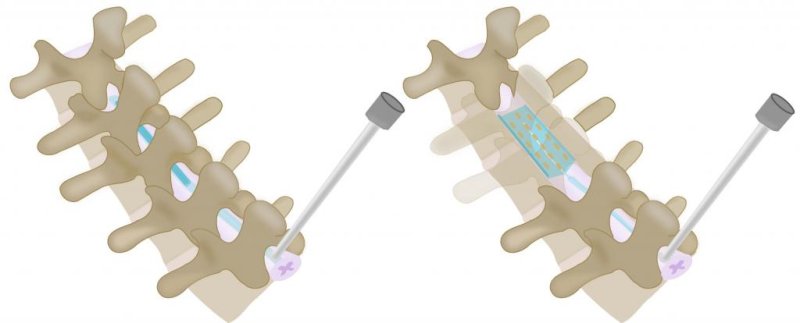A team of engineers and clinicians has developed an ultra-thin, inflatable device that can be used to treat the most severe forms of pain without the need for invasive surgery. Photo courtesy of the University of Cambridge
June 25 (UPI) -- An "ultra-thin," inflatable device may help treat the most severe forms of back and leg pain without the need for invasive surgery, the researchers who developed it said Friday.
The device, made with a combination of soft robotic fabrication techniques, ultra-thin electronics and microfluidics -- or microscopic droplets of fluid -- is designed to deliver small electrical currents to the spinal cord to disrupt pain signals, they said.
About the width of a human hair, it is inserted into a needle and implanted into the epidural space of the spinal column, the same area in which injections are administered to control pain during childbirth, according to researchers from the University of Cambridge in England.
Early tests of the device suggest that it could be an effective treatment for severe leg and back pain when they are not effectively treated by prescription painkillers, although the device still needs to be evaluated in clinical trials.
The initial findings with the device were published Friday by the journal Science Advances.
"Our goal was to make something that's the best of both worlds -- a device that's clinically effective, but that doesn't require complex and risky surgery," study co-author Christopher Proctor said in a press release.
"This could help bring this life-changing treatment option to many more people," said Proctor, a professor of engineering at Cambridge.
As many as one in 12 Americans lives with back pain that does not respond to conventional treatments such as non-steroidal anti-inflammatory drugs or opioids, the Centers for Disease Control and Prevention estimates.
In recent years, researchers have explored the use of spinal cord stimulation stimulation devices that deliver small electrical pulses to the nerves in the spine that transmit pain signals to the brain.
However, some of the most effective of these devices are bulky and require invasive surgery, while current smaller options are less effective at treating pain, according to Proctor and his colleagues.
For this new device, the researchers used a combination of flexible electronics from the semiconductor industry, tiny microfluidic channels used in drug delivery and shape-changing materials used in soft robotics.
Their finished device is just 60 microns thick -- about two-hundredths of an inch -- before implantation.
Once implanted, during a surgical procedure performed while the patient is under local anesthetic, the device is positioned in the epidural space. It is then inflated with water or air so that it unrolls like a tiny air mattress, covering a large section of the spinal cord.
It is then connected to a pulse generator using ultra-thin electrodes that can send the small electrical pulses to the spinal nerves, they said.
The device was able to effectively deliver these pulses on a human cadaver model, according to the researchers, who are partnering with a manufacturer to further develop it.
They hope to begin tests in patients within two to three years.
"An effective device that doesn't require invasive surgery could bring relief to so many people," co-author Damiano Barone said in a press release.
"The way we make the device means that we can also incorporate additional components -- we could add more electrodes or make it bigger to cover larger areas of the spine with increased accuracy," said Barone, a professor of clinical neurosciences at Cambridge.















